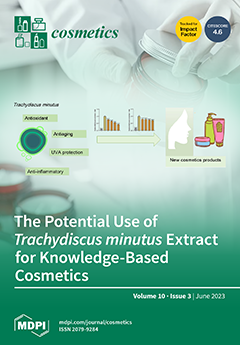The present study aims at valorizing Moroccan
Henna (
Lawsonia inermis) by developing healing formulations for cosmetic and therapeutic uses. For such a goal, the plant was collected from three locations in southeastern Morocco (Alnif, Tafraoute Sidi Ali and Tazarine). Phytochemical analysis
[...] Read more.
The present study aims at valorizing Moroccan
Henna (
Lawsonia inermis) by developing healing formulations for cosmetic and therapeutic uses. For such a goal, the plant was collected from three locations in southeastern Morocco (Alnif, Tafraoute Sidi Ali and Tazarine). Phytochemical analysis of
Henna leaves was performed by determining phenolic compound contents, and flavonoids and tannins in it, through its aqueous extracts. Then, specific formulations were prepared using aqueous extracts of
L. inermis to assess their in vivo wound healing potential in Swiss albino mice used as animal models. Results disclosed that phenolic compounds (13.48%), as well as flavonoid (9.25%) and tannin (2.57%) contents are higher in
Henna leaf extracts from Alnif, while Tazarine
Henna aqueous extract was found to be richer in saponins (0.32%). Exclusion chromatographic analysis on Sephadex G50 gel corroborates the obtained results and shows that Lawsone levels (
Henna coloring agent) are higher in
Henna collected from Alnif. Aqueous
Henna leaf extracts, at a dose of 10% in petroleum jelly, have been assessed for their ability to heal induced burns in mice. Healing monitoring, carried-out with
Henna extracts on mice batches and those of two control batches (mice batch treated with petroleum jelly alone and batch treated with petroleum jelly containing 1% (flamazine), showed a great reduction in burnt surface with an accentuated contraction percentage (CP) and complete re-epithelialization duration (CRD) at 21 days in the 3 studied
Henna-based formulations. These findings suggest the interest of potential development of
Henna-based formulations, as a source of phenolic compounds, for further dermatological, cosmetic and therapeutic applications.
Full article





